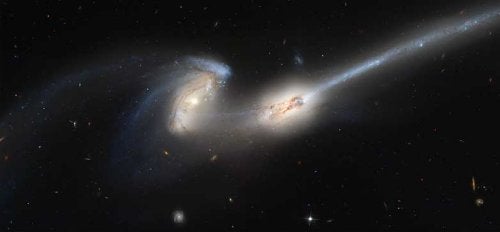Also known as NGC 4676, “The Mice” are a pair of nearly identical spiral galaxies seen during the early stages of a merger. They will eventually form one large elliptical galaxy. According to simulations, we are seeing this colliding pair approximately 160 million years after their closest encounter. The long tail on the right galaxy is actually curved, but appears straight because we see it edge-on. The formation of bright blue waves of hot, young star clusters (seen especially well in the left galaxy) has been triggered by the galactic interaction. The galaxies lie 300 million light-years away in the constellation Coma Berenices. This image was taken on April 7, 2002, by the Hubble Space Telescope’s Advanced Camera for Surveys.
NASA / ACS Team (H. Ford et al.)
In April 2002, the brand-new Advanced Camera for Surveys (ACS), just installed on the Hubble Space Telescope, took aim at a pair of colliding spiral galaxies collectively known as NGC 4676. Long tails of stars and gas stretch from both galaxies, prompting astronomers to nickname the pair “The Mice.” The new ACS image of “The Mice” showed more detail and more stars in the two galaxies than had ever been seen before.
To learn more about how “The Mice” came to be, astronomers Josh Barnes of the University of Hawaii and John Hibbard of the National Radio Astronomy Observatory tested numerous scenarios before finding one that matched our current view of the crashing galaxies. According to the computer simulation, we are looking a two nearly identical spiral galaxies about 160 million years after they first made contact. By advancing the simulation into the future, the astronomers learned that “The Mice” will eventually merge into one large elliptical galaxy. The stars and gas that today make up the galaxies’ long tidal tails will ultimately come crashing in again to become part of the new galaxy.
The link below is a time-step from Barnes and Hibbard’s simulation and represents the current state of NGC 4676. Click on the link to download a 3.5-MB animation illustrating the collision between the two galaxies of “The Mice.” The animation pauses at the present phase before continuing into the future to show the galaxies’ eventual merger into a single elliptical galaxy.










